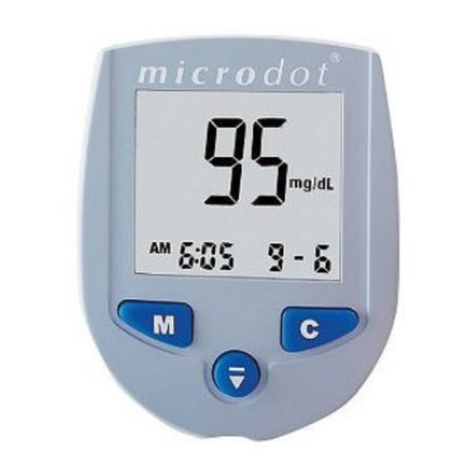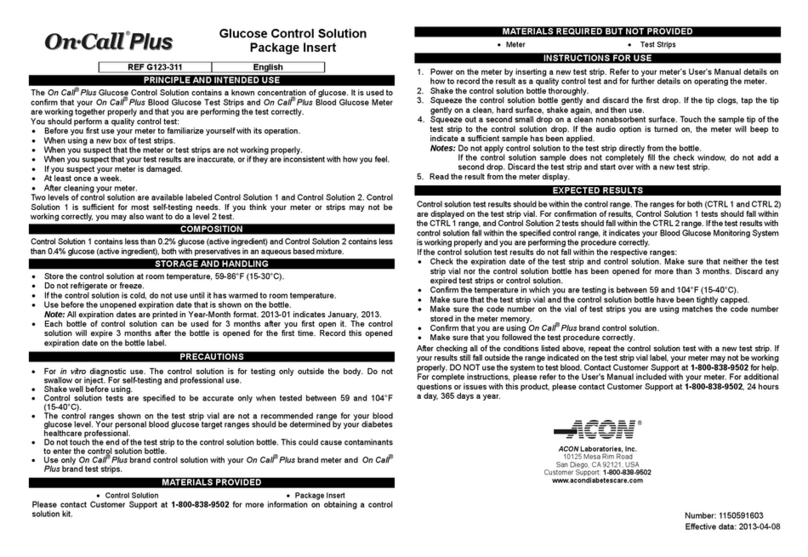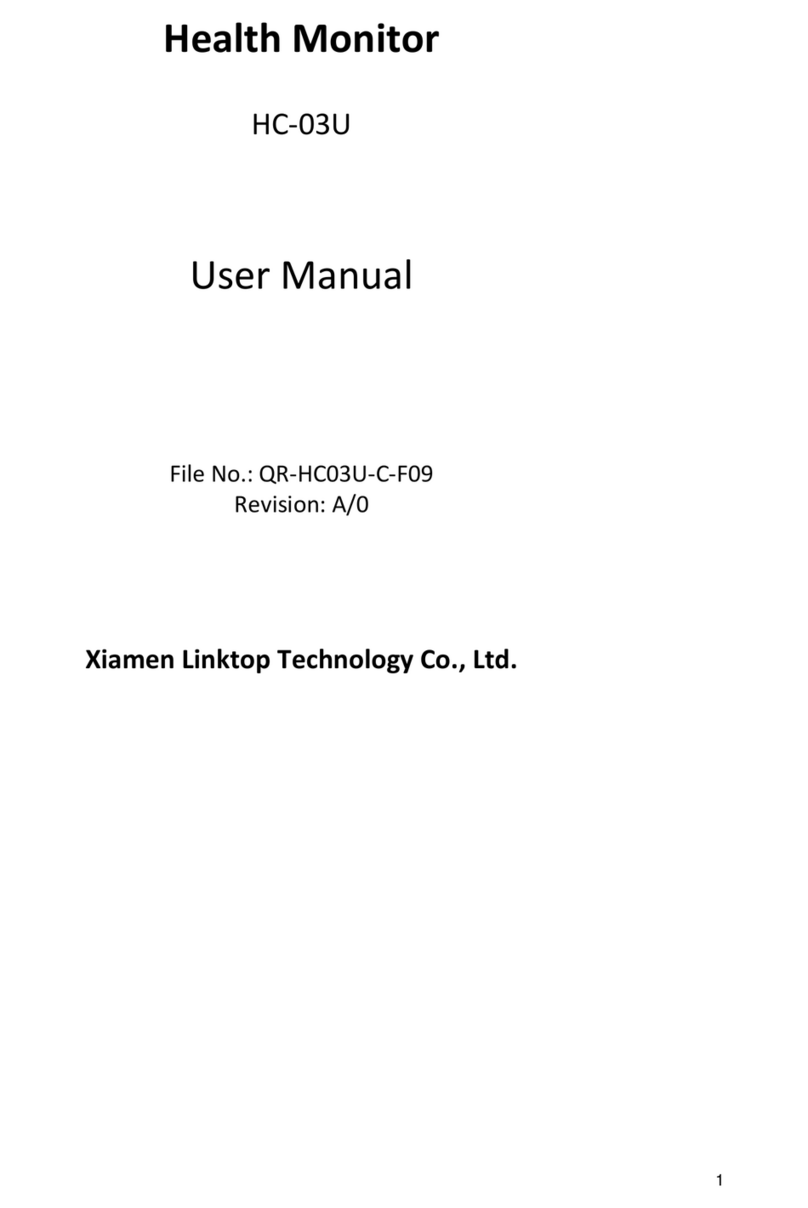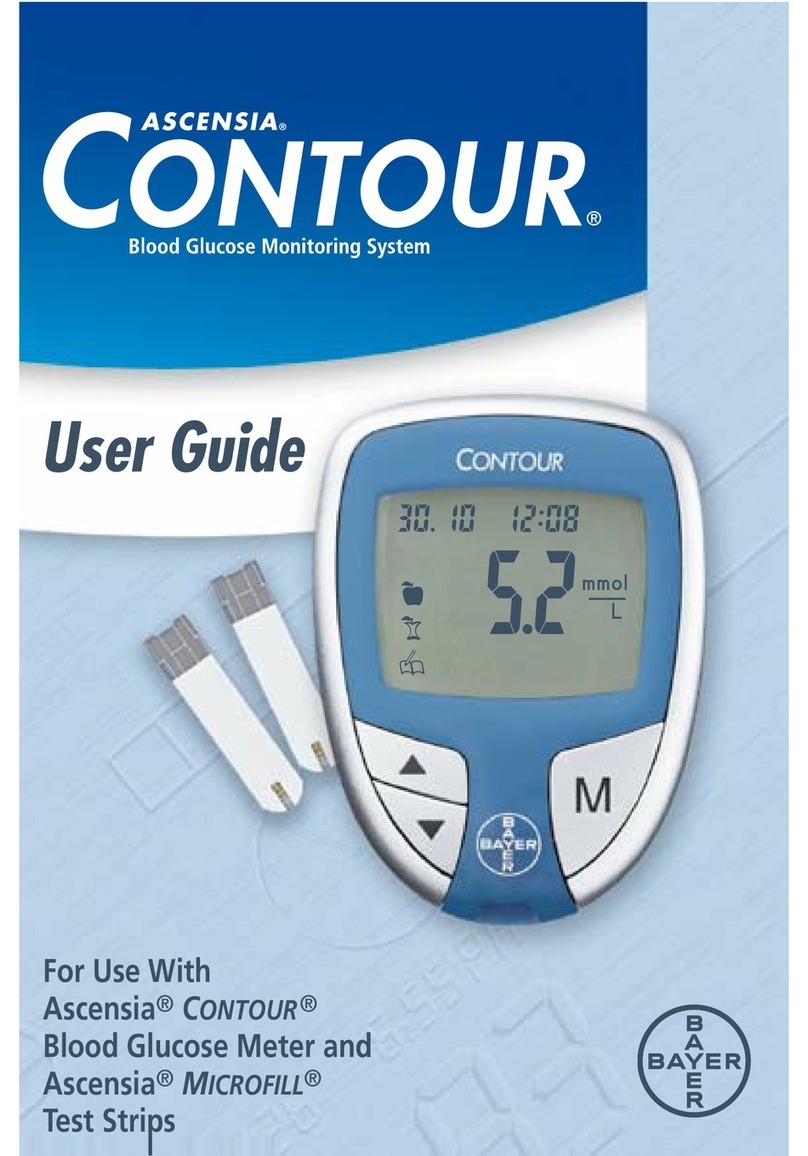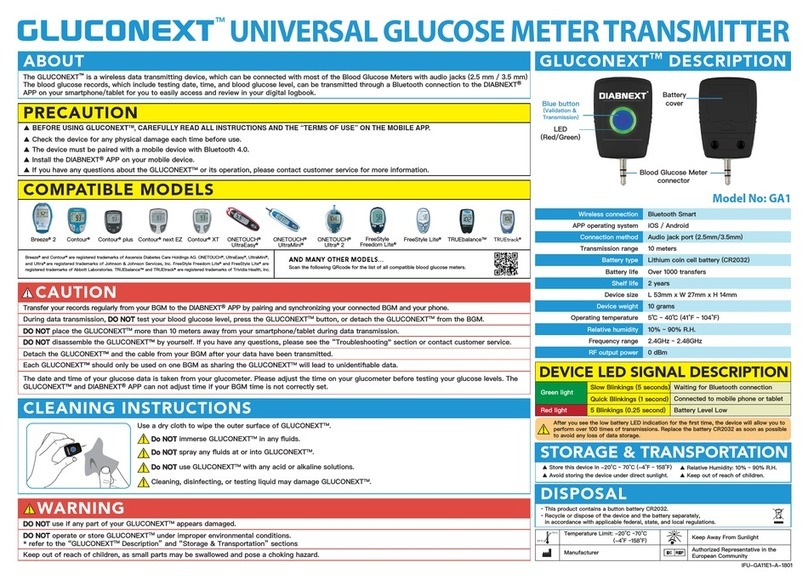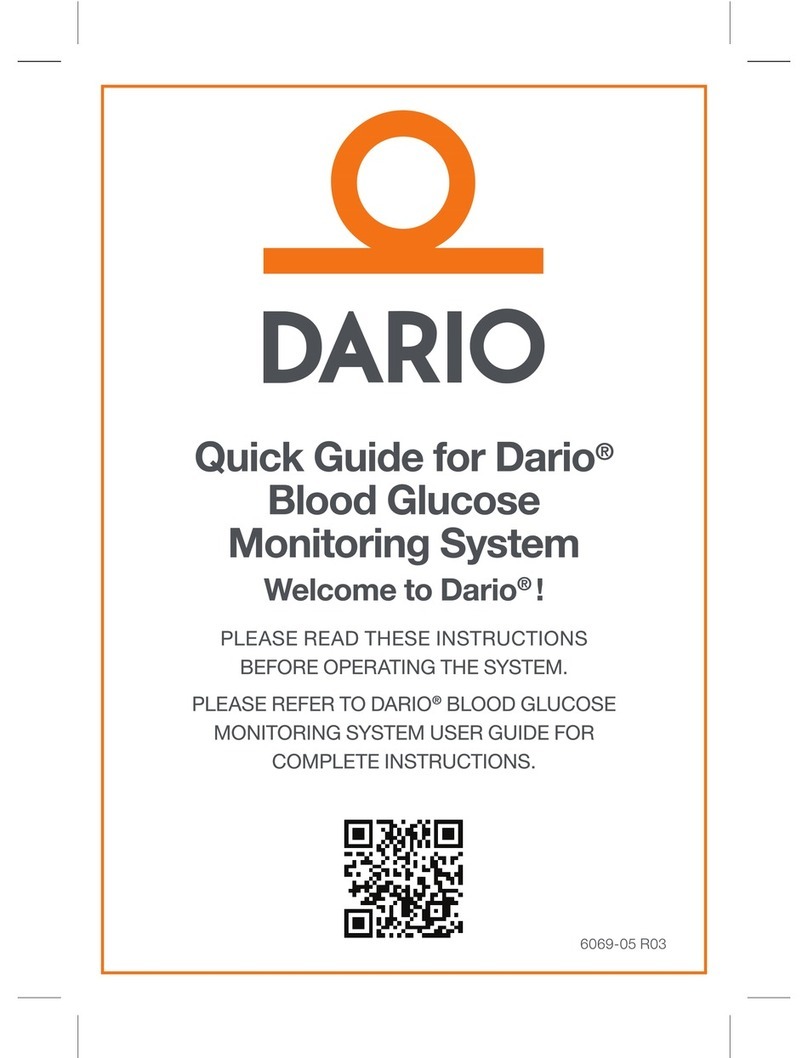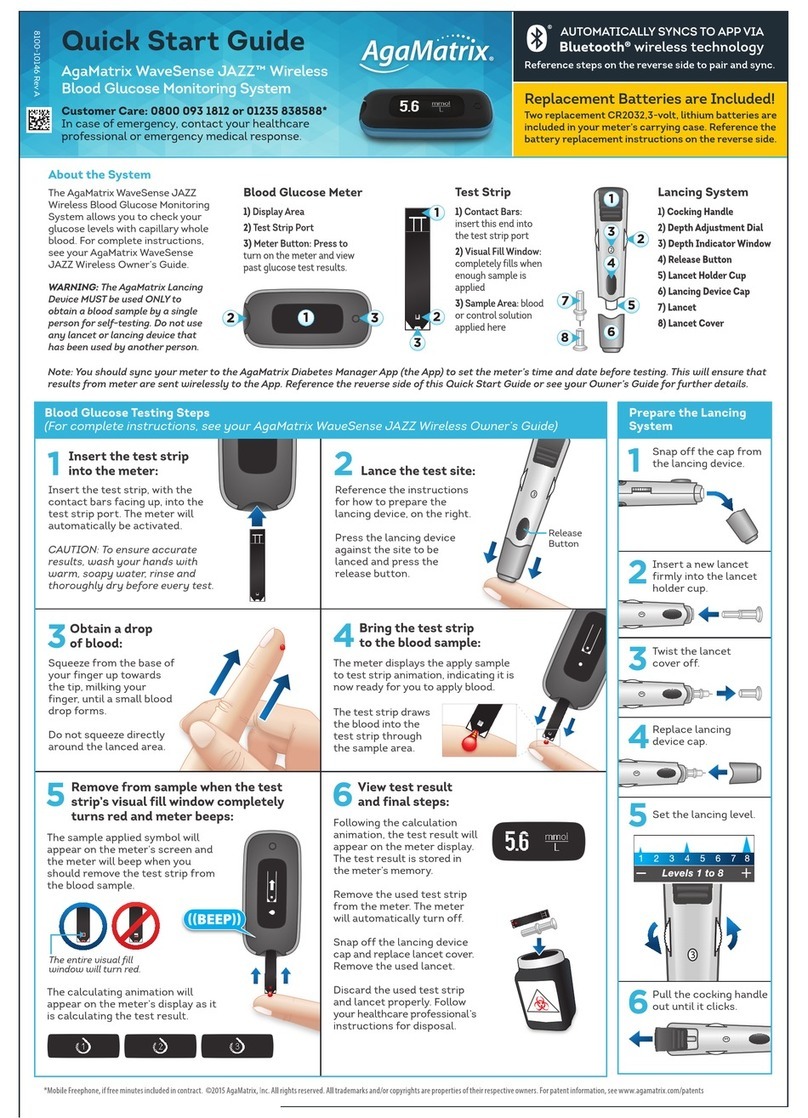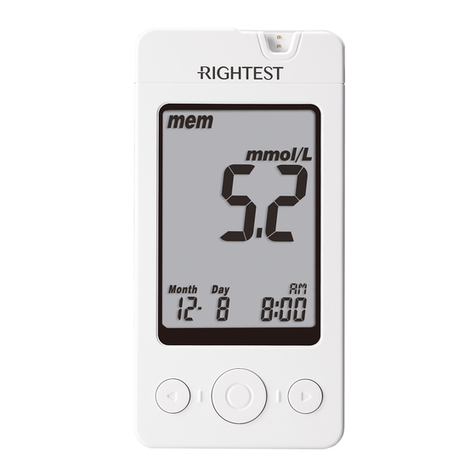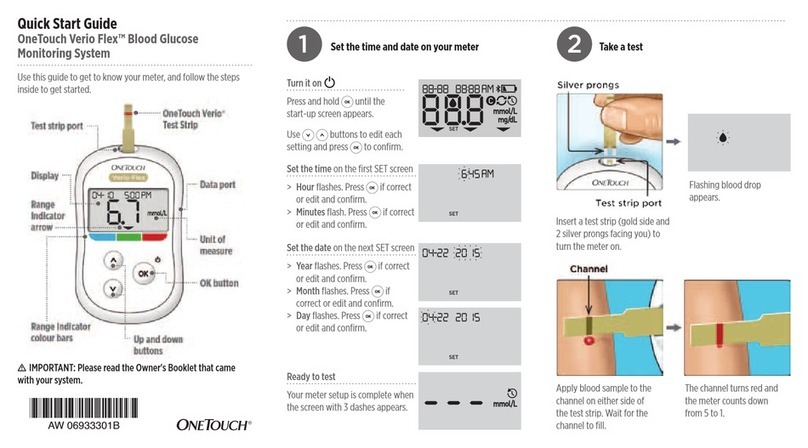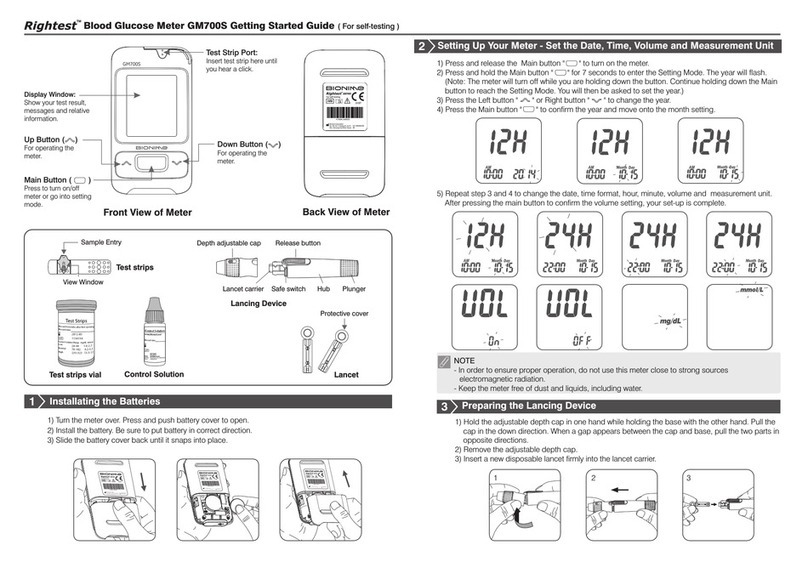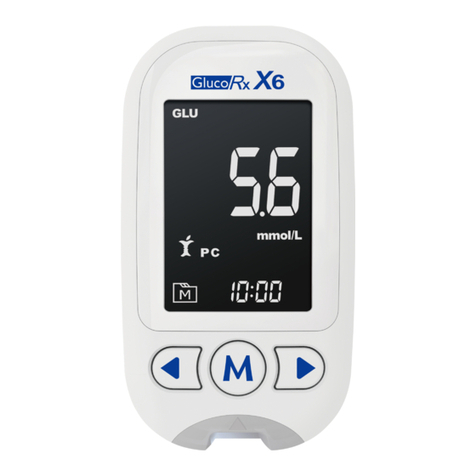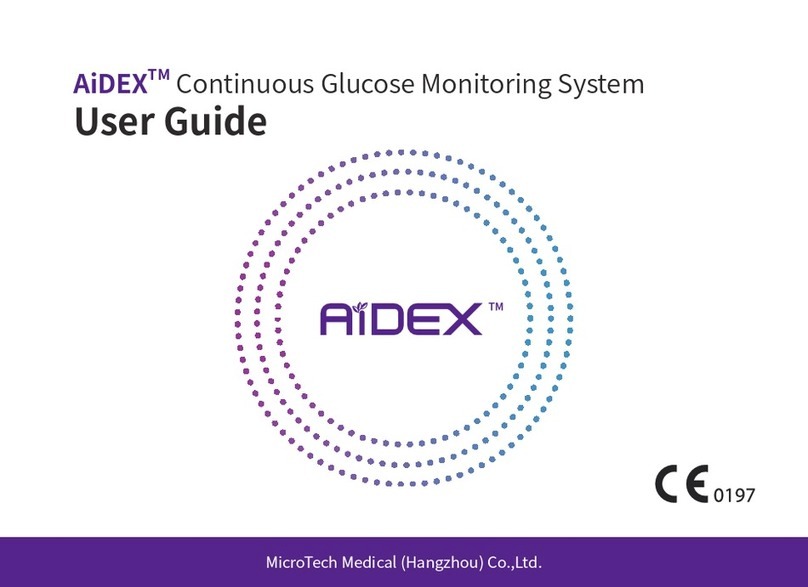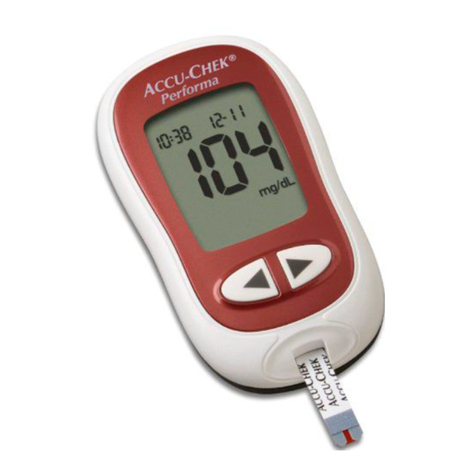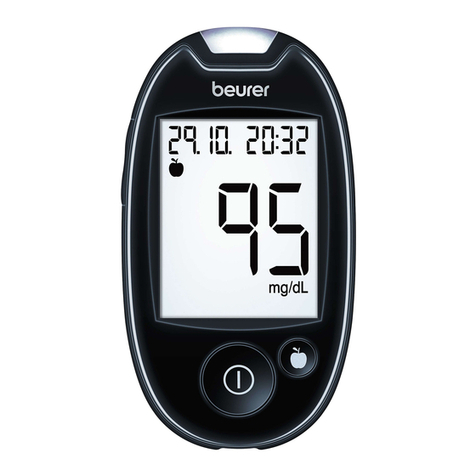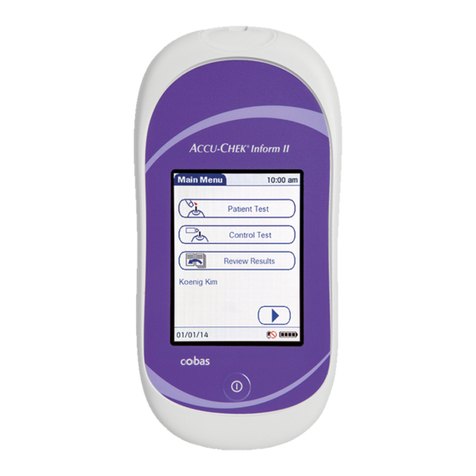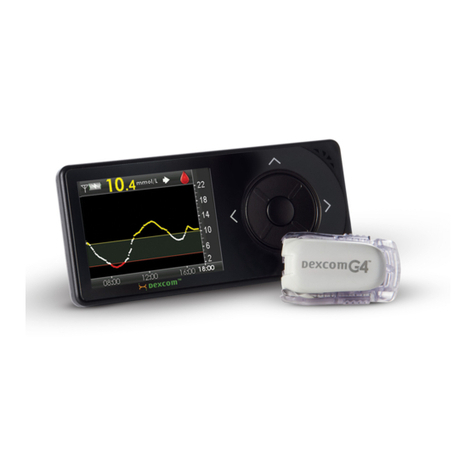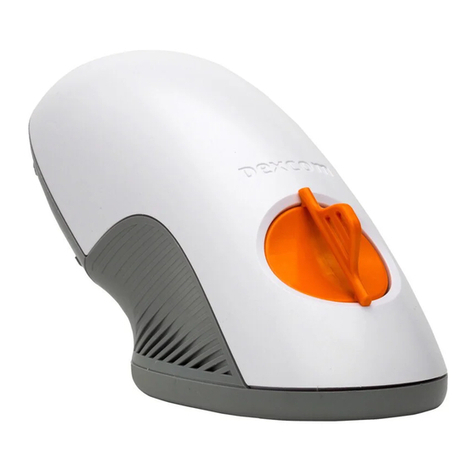Empecs Medical Device Medisign MM1100 BT User manual

Read this User Manual carefully before you start the test and do a quality
control test. If you have any questions about the control test consult with your
healthcare professional. Confirm the measuring unit on the display is correct
with ever test result.
Call Customer Service Toll-Free
24 hours a day, 7 days a week
1-888-885-6677
or visit our website
Manufactured by:
Tianjin Empecs Medical Device Co.,Ltd.
No.35 and 37, Yingcheng Street, Hangu,
Binhai New Area, 300480 Tianjin China
www.empecs.com
Medisign MM1100 BT
Blood Glucose Monitoring System
User Manual

I ii
Sign of Trouble
If you are experiencing any of the issues below, call customer service at
1-888-885-6677.
lThe meter doesn't power on when the new test strip is inserted into the meter.
lThe meter doesn't power on when you replace the batteries.
lThe meter doesn't show the test result after the test is completed.
lThe LCD does not display correctly or is distorted after changing the batteries.
If you encounter any issues including the ones mentioned above, call
customer service at 1-888-885-6677.
Important Safety Instruction
lBlood glucose meters are at high risk of contamination with blood-borne pathogens
such as Hepatitis B Virus (HBV), Hepatitis C Virus (HCV), and Human
Immunodeficiency Virus (HIV).Transmission of these viruses from user to user has been
documented due to contaminated blood glucose devices. Accordingly, cleaning
and disinfecting meters between users can prevent the transmission of these viruses
through indirect contact.
lThe meter and lancing device are for single patient use. Do not share them with
anyone including other family members. Do not use on multiple patients.
lAll parts of the kit are considered as biohazards. The system may transmit infectious
diseases, even after it has been cleaned or disinfected.
lIf the meter is being operated by a second person who is providing testing assistance
to the user, the meter and lancing device should be disinfected prior to use by the
second person.
lReferences
1. FDA Public Health Notification: Use of Fingerstick Devices on More than One Person
Poses Risk for Transmitting Blood Pathogens:Initial Communication (2010)
http://www.fda.gov/MedicalDevices/Safety/AlertsandNotices/ucm224025.htm
2. CDC Clinical Reminder: Use of Fingerstick Devices on More than One Person Poses a
Risk for Transmitting Blood-borne Pathogens (2010)
http://www.cdc.gov/injectionsafety/Fingerstick-DevicesBGM.html

Contents
nAbout Your New System
Welcome
Intended Use
Application
Test Principle
Special Features
Usage and storage
Important Information
System Components
nTesting Your Blood Glucose
Disinfection Before test
Performing a Blood Glucose Test
Flagging Test Results
Handling the Used Test Strips
Alternate Site Testing (AST)
nMeter Setup, Memory and Downloading
Setting up Your Meter
01
01
02
02
03
04
05
09
13
14
22
23
24
28
Reviewing Test Results
Downloading Test Results to a PC
nPairing Your Meter
How to Pair Your Meter
nControl Test
Performing a Control Test
Understanding Control Test Results
nMaintenance and Troubleshooting
Cleaning and Disinfecting
Replacing the Batteries
Screen Messages
Troubleshooting
nTechnical Information and Warranty
Specifications
Warranty
Disposing of your Meter
Additional Supplies Available
.........................................................................................................
...................................................................................................
.....................................................................................................
...................................................................................................
.............................................................................................
........................................................................................
....................................................................................
......................................................................................
..................................................................................
.................................................................
......................................................................................
.........................................................................
...........................................................................
....................................................................................
.....................................................................................
.................................................................
...................................................................................
...............................................................................
...............................................................
.............................................................................
..................................................................................
............................................................................................
...............................................................................................
..................................................................................................
...........................................................................................................
.................................................................................
........................................................................
28
34
37
40
44
45
50
52
56
58
60
61
63

0201
About Your New System
Welcome
Thank you for selecting the Medisign MM1100 BT Blood Glucose Monitoring
System. This user manual is designed to provide you with information on how to
use the Medisign MM1100 BT Glucose Monitoring System. Follow the instructions
carefully that are detailed in this manual. Before using your monitoring system
for the first time, please read this manual carefully and If you have any
questions, contact Customer Service at 1-888-885-6677, anytime-24 hours a
day. You can also obtain information at www.empecs.com.
Intended Use
Medisign MM1100 BT Blood Glucose Monitoring System is intended for the
quantitative measurement of the glucose in fresh capillary whole blood drawn
from fingertip, palm, and forearm by a single patient (lay user) as an aid in the
management of diabetes. It is intended for self testing by persons at home, for
single patient use only, and should not be shared.
It is intended for use outside the body (in-vitro diagnostic use only) and not for
the diagnosis of or screening of diabetes or for neonatal use.
The alternative site testing (palm and forearm) should be done only during
steady state times (when glucose in not changing rapidly).
Application
Medisign MM1100 Blood Glucose Test Strips are for in-vitro diagnostic use and
for self testing only. The Medisign MM1100 BT Blood Glucose Meter is not a
substitute for your physician or Healthcare Professional. Use the Medisign
MM1100 BT Blood Glucose Meter in conjunction with your Healthcare Program.
Test Principle
Glucose in the blood sample reacts with glucose oxidase on the test strip and a
harmless electrical current is produced. The strength of these currents change
with the amount of glucose in the blood sample and the Medisign MM1100 BT
Blood Glucose Meter automatically interprets this reaction.

03 04
Glucose measurements are reported as plasma equivalents. This system uses
plasma equivalent methodology. Results that use a plasma equivalent method
are approximately 11% higher than those obtained with whole-blood
equivalent test strips.
Special Features
lAccurate result in 5 seconds using only 0.5㎕ blood sample.
lThe Medisign MM1100 BT Glucose Meter identifies the test strip code
automatically.
lStores up to 300 test results.
lBlood glucose measurement units are pre-set in mg/dL.
Usage and Storage
lBefore using your monitoring system, please place it in the environment of the
system's normal operating temperature range of 50-104 ℉ for about
twenty (20) minutes.
lDo not allow dirt or dust into the test strip port in order to avoid affecting the
monitoring system's accuracy.
lDo not attempt to repair or alter your monitoring system.
lDo not put the monitoring system near any electromagnetic field. (e.g. TV,
microwave oven, mobile phone)
lHandle your monitoring system with care.
lKeep away from direct sunlight and humid conditions.
lPlease use a soft cotton cloth to wipe the system.
lDo not use a corrosive product (e.g. Benzene, Acetone) to clean your
monitoring system.

05 06
Important Information
lMake sure to use your test strip immediately after retrieving it from the vial,
be sure to keep the test strip vial closed tightly at all times.
lFor the most accurate results, make sure your hands are clean and dry
before removing the test strips from their vial.
lDo not touch test strip slit.
lDo not use test strips that have expired, using expired test strips may cause
inaccurate test results.
lNever reuse a test strip that has had either blood or control solution
applied. The Medisign MM1100 Test Strip is for single use only.
lThis product is not recommended for pregnant women, newborns or if you
are severely dehydrated.
lBefore the test you must make sure that the code number displayed on
the meter matches the code number on the test strip vial.
lKeep your Medisign MM1100 BT Blood Glucose Meter, lancing device,
lancets and control solutions out of reach of children or pets.
lBe sure to check the glucose measurement unit on the meter before the
test.
- This meter is preset to mg/dL.
- mg/dL is the unit of measurement used in the US.
lMake sure you close the test strip vial is closed tightly and store at indoor
area between 39 ~ 86℉,10~90%RH. Do not freeze.
lKeep test strips away from direct sunlight and heat.
lUse this system only for blood glucose test.
l
℉
Before using the Medisign MM1100 BT Blood Glucose Monitoring System,
please read this manual carefully.
lThe meter and test strips should be handled at the same temperature.
lFor accurate test results, keep the Medisign MM1100 BT Blood Glucose
Monitoring System operating temperature at a range between 50-104 for
more than twenty (20) minutes before testing.

07 08
lDo not use any anticoagulants or preservatives other than heparin when
collecting capillary blood into test tubes.
lBe sure to clean and disinfect your Medisign MM1100 BT Blood Glucose
Meter regularly.
lDo not reuse the test strips, test strips are single use only.
lYou may use this system at altitude up to 10,000 feet.
lClean and disinfect your Medisign MM1100 BT Blood Glucose Meter at
least once per week.
Inaccurate results may occur for individuals or patient in shock.
Inaccurate results may occur for individuals experiencing a
hyperglycemic-hypersmolar state with or without ketosis. Critically ill
patients should not be tested with this blood glucose meter.
Interferences: Acetaminophen, salicylates, uric acid, ascorbic acid
(vitamin C) and other interferent substances in normal blood or normal
therapeutic concentrations do not significantly affect results, however
abnormally high concentrations in blood may cause inaccurate results.
lThe Medisign MM1100 BT Blood Glucose Monitoring System is for testing
outside of the body (in-vitro diagnostic use).
l
l
l
CAUTION: Use only Medisign MM1100 Test Strips with your Medisign MM1100
and Medisign MM1100 BT Blood Glucose Meters.
l Testing under out of the specification range may cause inaccurate results.
l Patients undergoing oxygen therapy may yield false low results.
l Lipemic samples (triglycerides) in excess of 1,500 mg/dL may produce
elevated results.
l Hematocrit is the percentage of red blood cells in the blood. HCT levels of
30-55% do not affect glucose measurements with this meter. If you do not
know your hematocrit level, consult with your healthcare professional.
l This test strip is not for use with arterial, venous, neonatal, serum or plasma
samples.
l Testing out of HCT level range of (30~55%) and recommended storage
conditions may cause inaccurate results.
lDispose of used test strips and lancets according to instructions from your
healthcare provider.

09 10
Medisign MM1100 BT Blood Glucose Meter
The Complete Medisign MM1100 BT
Blood Glucose Monitoring System
The Medisign MM1100 BT Blood Glucose Monitoring System includes the
Medisign MM1100 BT Meter, Ten(10) Medisign MM1100 Test Strip, Lancing
Device, Lancets, Carrying Bag, User Manual, Warranty Card, (2) 3.0 Volt CR2032
Lithium Batteries and Logbook.
Medisign MM1100 test strips and Medisign Glucose Control Solution can be
provided by contacting your supplier, or for additional information you can
contact Customer Support at 1-888-885-6677.
Display
'M' Button
'C' Button
Test Strip port
Serial port Battery Lid
Label
Test Strip Ejector

11 12
Explanation of Display
Medisign MM1100 Blood Glucose Test Strip
lUse Medisign MM1100 Blood Glucose Test Strips with the Medisign MM1100
and Medisign MM1100 BT Blood Glucose Meter.
lCheck the expiration date of your test strips before using.
lWrite the opening date of the new test strip vial in order to avoid using any
expired products.
Lot Number
Expiration Date
Sample
Channel
Test Strip Vial Medisign MM1100 Blood Glucose Test Strip
A
B
Low Battery Warning
Stored Test Results
Test Results
Unit of Measurement
Temperature Error
No Beep
Pre meal / Post meal Mark
Ready to Test
Control Solution
Average Result
Month / Date
Time
Bluetooth (wireless RF on)
b

15 16
7. Adjust the puncture depth setting if necessary by turning the lancing device
cap, number 1 is the shallowest depth while number 5 is the deepest. Slide
the ejection/cocking control barrel back until it clicks. If it does not click, the
lancing device may have been cocked when the lancet was inserted.
8. Hold the lancing device firmly against your finger. Press the release button.
9. Gently squeeze your finger to assist the flow of blood. Do not squeeze
excessively on the puncture site.
789
4. Insert a test strip to turn on the meter. Make sure it is inserted completely
without bending the test strip.
5. The meter identifies the code number automatically. Compare the code
number displayed on the LCD with the code number shown on the test strip
vial. If they do not match try again with an another test strip. If the problem
persists contact customer support at 1-888-885-6677.
6. When the blood symbol appears, you can proceed with your test.
64 5
A01

13 14
Performing a Blood Glucose Test
1. Remove your lancing device cap.
2. Install the new lancet into your lancing device.
3. Remove the protective cap from the lancet. Replace the lancing device
cap.
NOTICE: Refer to the lancing device instruction for additional detailed
information. The lancing device instruction depicted in this manual is for most
universal lancing devices.
1 2 3
Testing Your Blood Glucose
Disinfect Before Testing
lBefore testing, wash your hands with soap and water and dry thoroughly.
lUse an alcohol prep pad to wipe the area before testing.
lWait until the alcohol dries completely.

17 18
10. Hold the tip of the test strip to the drop of blood, the test strip will
automatically draw the blood into the test strip. When the test strip has
enough blood the meter will beep and count down from five seconds. After
five seconds your test result will appear.
NOTICE: When the blood sample is not sufficient, the display screen will show
the message of "Er 4"(Please refer to error messages in this manual.)
CAUTION:
lDo not drop the blood directly on the end of the test strip.
lThe sample channel at the end of the test strip should show full. When you
hear the beep sound, you have enough blood in the test strip.
lInaccurate results may occur for individuals or patient in shock.
Inaccurate results may occur for individuals experiencing a
hyperglycemic-hypersmolar state, with or without ketosis. Critically ill
patients should not be tested with a blood glucose meter.
10

19 20
11 12
11. The test result will appear after the meter counts down from five (5)
seconds. Keep the meter still while it is counting down.
12. After five (5) seconds you will hear a second beep sound and your test
result will be displayed on the LCD screen. You can remove the test strip by
pushing the test strip ejector on the back of the meter and the meter will
shut off automatically.
NOTICE:
If the test result is abnormal, please retest with a new test strip. If the test result
also has a problem, please refer to the Troubleshooting section in this manual.
CAUTION:
lDo not leave the lancet in the lancing device after use, be sure to dispose
of properly.
lIf you have taken the cap off of the lancet and the lancet has fallen to the
ground, do not use it. Make sure you dispose of it and replace it with a new
lancet.
lAlways dispose of the used lancets in a biohazard container.
lKeep your Glucose Meter, test strips, control solution, lancing device and
lancets out of reach of children or pets at all times.
lDo not reuse lancets, lancets are for single use only.

21 22
lBlood glucose meters are at high risk of becoming contaminated with
blood-borne pathogens such as Hepatitis B Virus (HBV), Hepatitis C Virus
(HCV), and Human Immunodeficiency Virus (HIV). Transmission of these
viruses from resident to resident has been documented due to
contaminated blood glucose devices. Accordingly, cleaning and
disinfecting of meters between resident uses can prevent the transmission of
these viruses through indirect contact.
lThe meter and lancing device are for single patient use. Do not share them
with anyone including other family members. Do not use on multiple
patients.
lAll parts of the kit are considered bio hazardous and can potentially
transmit infectious diseases, even after you have performed cleaning and
disinfection.
lUser should wash their hands thoroughly with soap and water after handling
the meter, lancing device or test strips.
lPlease see the section on "Cleaning and Disinfection" to clean and disinfect
the meter or lancing device.
Flagging Test Results
If you want to flag pre-meal, post-meal or control solution readings press the
Button after your test result is displayed. The icon for post-meal ( ) will be
displayed on your screen. Press the Button to toggle between pre-meal ( ),
post-meal ( ) and control solution ( ). After you have identified the activity
you would like to flag simply remove the test strip. (see explanation of display on page
11)
'M'
'C'
NOTICE:
Control Solution Test results are not included in the 14-day average.

23 24
Handling Used Test Strips
1. Be sure to document your test result by writing it in your logbook after your
test. You can then take your logbook to your physician who can review your
results.
2. Use the test strip ejector located on the back of the meter to remove the
used test strip.
3. The meter will turn off automatically once the test strip is removed.
4.The used test strip should be handled carefully and disposed of properly.
Alternate Site Testing
Contact your Healthcare Professional before using any alternative sites to test
your blood glucose.
lAlternative site results may be different from fingertip results when glucose
levels are changing rapidly (e.g., after a meal, after taking insulin, or during or
after exercise).
lUse alternative site testing only two hours or more after taking insulin, two hours
or more after a meal, two hours or more after exercise.
lDo not use alternative site testing if you are aware that your glucose level is
not as stable as usual, or if you think you may have hypoglycemia (low blood
glucose) hyperglycemia (high blood glucose), or you think your blood glucose
may be rising or falling rapidly.
lDo not use alternative site testing if your alternative site testing results do not
match the way you feel.
lAST measurements should never be used to calibrate continuous glucose
monitors (CGM).
lAST measurements should never be used in insulin dosing calculations.

25 26
Do not rely on test results at an alternative sampling site, but use samples taken
from the fingertip, if any of the following applies:
lyou think your blood sugar is low.
lyou are not aware of symptoms when you become hypoglycemic.
lthe site results do not agree with the way you feel.
lafter a meal.
lafter exercise.
lduring illness.
lduring times of stress.
CAUTION:
lNever change your treatment without first consulting your Physician or a
Healthcare Professional.
lNever ignore symptoms of high or low blood glucose.
lIf your blood glucose does not match how you feel, perform a fingertip
test to confirm your result. If the fingertip test result still does not match
how you feel, call your Healthcare Professional.
Lancing and Sampling from an Alternate
Site
Sampling from your palm or forearm allows you to use your fingertips less often.
You may find that obtaining a blood sample from an alternative site is less
painful than using a fingertip. Getting a blood sample from your forearm or
palm is different than getting a sample from your fingertips.
lForearm sampling: Choose a fleshy area of the forearm away
from the bone, visible veins and hair. Sometimes there is less
blood flow to the forearm than to the fingertips. To help you get
a large enough drop of blood, you may gently massage or
apply warmth to the site to increase blood flow.
lPalm sampling: Choose a fleshy area on the palm below your
thumb or little finger. Select an area away from veins or deep
creases which may cause your blood sample to smear.
Foream
Palm

27 28
The Lancing Device Clear Cap is used for forearm and palm sampling only.
Replace the lancing device cap to the clear cap and follow the same steps
as descried in the chapter titled "Performing Blood Glucose Test".
NOTICE:
lYou may need to wait a little longer to get a large enough drop of blood
from the forearm or palm. Do not squeeze the site excessively.
lIf the sample drop of blood runs or spreads due to contact with hair or a
crease in your palm, do not use that sample. Try puncturing again in a
smoother area.
lYou may have to adjust the lancing device to a deeper setting to get a large
enough drop of blood.
Meter Setup, Memory and Downloading
Setting up Your Meter
1. Press and hold the button for roughly three seconds, you will hear a beep
sound and the LCD Screen will display the screen icons of the meter.
2. Continue to hold the button and "SET" will appear on the screen.
'M'
'M'
1 2

29 30
3 4
3. Setting the Month : When the month blinks, press and release the 'C' Button
until the correct month appears, then press the Button to set the correct
month and move to the date setting.
4. Setting the Date : When the date blinks, press and release the Button until
the correct date appears, then press the Button to set the correct date
and move to the time setting.
'M'
'C'
'M'
5. Setting the Time Format : The meter can be set to show the time in AM/PM 12
hour format or 24 hour "Military Time". With the "12 h" blinking press the 'C'
Button to move between 12 h and 24 h, then press the 'M' Button to set and
move to the hour setting.
5 6
6. Setting the Hour : When the hour blinks, press and release the Button until
the correct hour appears, then press the Button to set the correct hour
and move to the minute setting.
'C'
'M'
7. Setting the Minute: When the minute blinks, press and release the 'C' Button
until the correct minute appears, then press the 'M' Button to set the correct
minute and move to the year setting.
8. Setting the Year: The year will appear on the screen, press and release the 'C'
Button until the correct year appears, then press the 'M' Button to set the
correct year and move to confirming the unit type mode.
7 8

31 32
9. Measurement Unit : The glucose measurement unit is defaulted to "mg/dL".
Press the 'M' Button to move on to turning the "Beep" sound on or off.
NOTICE: This cannot be changed, if you have any questions concerning the
Unit Type contact Customer Service at 1-888-885-6677.
9
CAUTION:
lUse of the wrong unit of measure may cause you to misinterpret your blood
glucose level, and incorrect treatment.
lContact your Healthcare Professional if you have any question about
measuring units. This meter is preset to mg/dL. mg/dL is the unit of measure
used in the U.S.
10
10. Turning the Beep Sound On or Off:
NOTICE: Turning the Beep sound On or Off does not affect your glucose
measurement.
The meter is preset to the beep sound
"ON". To turn the beep sound off on the meter press the 'C' Button until "OFF"
appears on the screen, then press the 'M' Button to confirm and move to
Deleting Your Test Results.

33 34
11 12 13
11. Deleting Your Test Result: Select the Button to toggle between YES and
NO . If you want to keep your readings in the memory toggle to NO then
select the Button to confirm.
12. If you want to delete all of the readings in the memory toggle to YES then
select the Button to confirm.
13. After deleting, the screen will show as pictured above. Press the Button
again and the meter will turn off.
'C' " "
" " " "
'M'
" "
'M'
'M'
Reviewing Test Results
1 2
1. Begin with the meter off. Press the Button, you will hear a beep sound and
the meter will turn on.
2.
'M'
" "
" "
The screen will display the date and time. After 2 seconds, the last 14 days
average result will be displayed with a sign 14 and the number of test
results for 14 days on the display. For example, 8n above the picture means
that there are eight (8) test results saved on the memory during the last 14
days.
DAY
AVG
Table of contents
